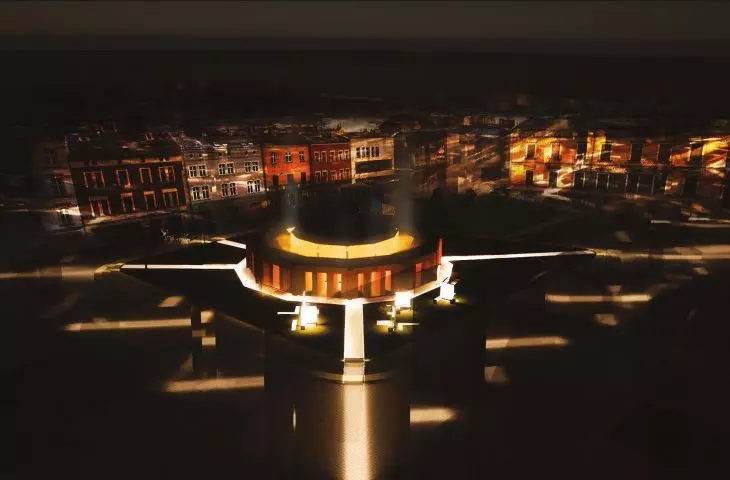Square of Tomorrow
proj.: Katarzyna Tokarz, Anastasia Matsiuk, Bartłomiej Pietryka (ASP), Filip Bolicki, Agata Złotek (IG UJ), Anass Obeidat, Aleksandra Rogoż (IS UJ), Jakub Werwiński (AGH)
[author's description]
The functioning of Plac Nowy reflects both the complex history of the Kazimierz district and the socio-economic changes in Poland. Aesthetically, the area is in chaos, and the commercial nature of the square makes coexistence between residents and tourists difficult. The authors of the project, aware of these problems, proposed solutions, using the idea of devzrost. They provoked an alternative view of the space in such a way as to limit the excessive influence of neoliberal values as much as possible. The commercial tradition of the square was symbolically marked by an arcade surrounding one of the edges of the square—but removed from the central part to prevent the fetishization of economic growth. The essence of the designed square is community. A well-organized and aesthetically pleasing space is meant to encourage concern for infrastructure and neighbors, as well as sharing. Underground spaces, were made available to tenants of the surrounding tenements, and have no strict function imposed. The thought was to put all the floors of the new square at the disposal of people who would like to develop their interests. The only clearly defined technology envisioned for implementation is an acoustic room. This solution would help solve the noise problem in the vicinity of the New Square, which residents complained about in surveys conducted. The remaining underground space is an area where workshops and fab labs are to be created, the interiors of which will be filled by potential users with such equipment and technology that will allow them to live sustainably. Ultimately, the idea is for these spaces not to focus on creation, but to allow the creative use of what is already there in Kazimierz, in the spirit of devzrost. Energy, culture, history, urban infrastructure and, above all, a diverse community.
See the full presentation of the project: board 1, board 2, board 3, board 4, board 5
Majim
proj.: Julia Korzec, Martyna Kubala (ASP), Maria Bołdok, Klara Lewandowska (IS UJ), Joanna Hałys (IG UJ), Łukasz Życiński (AGH)
[excerpt from author's description]
The idea is for the New Square to provide space for both social gatherings related to building interpersonal ties, meetings around eating and preparing food together, meetings of a cultural nature and those overtly related to joint activities. The main formal motif of the proposed transformation is the water at which the meetings would be held. At the focal point, in the center of the Roundhouse, rainwater is transported and stored with the help of architectural elements with adequate capacity. Thanks to this solution, water from the heavily sealed surface returns to circulation, under the surface of the earth. In the northern part of the square, rain gardens in containers with a retention function have been located, combined with the ear-pleasing hum of a closed-circuit fountain. The container rain gardens, together with adjacent plantings in the northern section of the square, provide cooling and insulation on hot days, as well as increasing biodiversity and partially reducing carbon dioxide. Majim is divided into two acoustic zones: a rest zone and a meeting zone, where a complex of miniature roundhouses, gazebos has been introduced.
The situational plan of the square has been preserved and even exposed by opening up to communication from Warshauer Street and Esther Street—a formal solution introduced in the form of a blue lane on the pedestrian route along the square—Majim directs passersby towards Kupa Synagogue and Remuh Cemetery.
Majim is a plastic transformation, not a destructive remodeling/revamping of New Square. The frontages of the historic buildings around the square remain intact, as does Okrąglak, which is further exposed by clearing the square. Its form is recycled, becoming the inspiration for modules with tables and seating—designed on an octagonal plan. The modular flowerbeds, along with the community kitchen, are put in the hands of local collectives, groups of residents, and can become foci for collective place-making, re-establishing the rules of the urban ecosystem and flows of goods.
See full presentation of the project: board 1, board 2, board 3, board 4
continued projects on next page





















































































